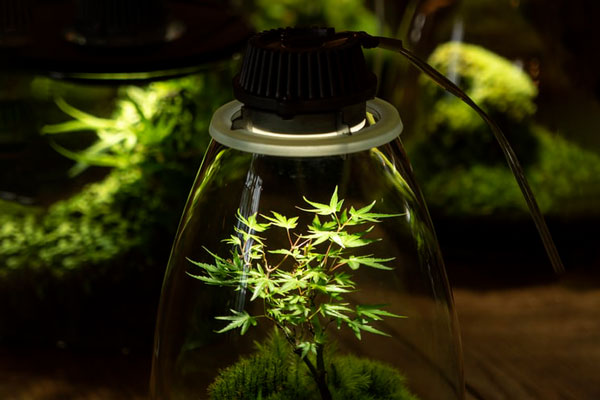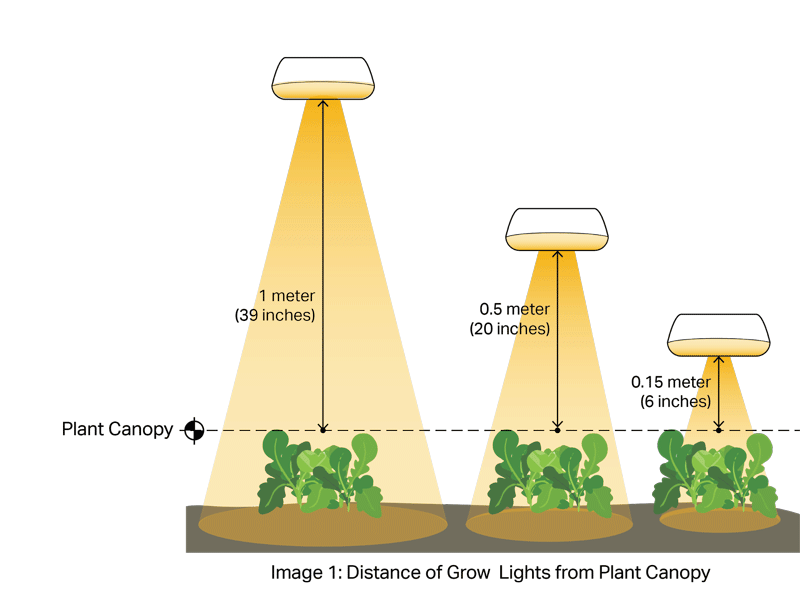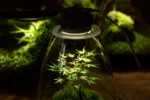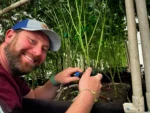
Today, more growers are moving away from traditional HID and fluorescent T5 grow lights and are installing LED lighting. LEDs emit less heat than HID sources which means that the proximity of LED grow lights to the canopy varies from that of traditional grow lights. It is important to also understand how optimal grow light distance impacts the different phases of plant growth.
This article outlines the different lighting needs for a variety of plants, (including cannabis) according to their growth stage. It also addresses how to determine the proper distance of LED lighting from the plant canopy to nourish plant growth, as well as the importance of PPFD (PAR), and other popular grow light terminology.
How To Measure Light for Plants
Let’s quickly define PAR and PPFD. PAR (Photosynthetically Active Radiation) describes the portion of the visible spectrum that plants “see” and use for photosynthesis (400nm-700nm). PPFD (Photosynthetic Photon Flux Density) measures the amount of light (PAR) a plant receives over time. PPFD represents the light density a plant receives over time and is measured in micromoles [of photons] per square meter per second (1).
A way to visualize PPFD is to imagine the sun is “pouring” light onto the plant leaves. As the sun pours light onto the plants, their leaves are collecting the energy. PPFD is the measurement of the amount of light (photons) the sun “pours” onto the plants over time. PPFD is an important metric because it helps growers accurately measure the light intensity for photosynthesis at the canopy level. It is also important because lights placed too close to the canopy can cause burning, bleaching, stunted growth, or discoloration.
LED Grow Light Distance Chart

| Distance from Plant Canopy | Intensity | PPFD / PAR | Coverage or “Light Footprint” |
| (meters/inches) | (Lux) | (μmol/m-2/s-1) | (m² / ft2)* |
| 2m / 79 inches | 955lx | 670 | 7.6m2 / 81.8ft2 |
| 1.5m / 59 inches | 1692lx | 1170 | 5.0m2 / 53.8ft2 |
| 1m / 39 inches | 3663lx | 1670 | 3.0m2 / 32.3ft2 |
| 0.5m / 20 inches | 12,500lx | 2170 | 1.5m2 / 16.1ft2 |
| 0.2m / 8 inches | 50,300lx | 2670 | 0.5m2 / 5.4ft2 |
* Coverage will vary based on the grow light being used. LED source shown here does not use a reflector to direct the light
Table 1 shows how a 600W LED grow light performs at varying distances from the plant canopy. It outlines light intensity (lux), delivers PPFD (μmol/m-2/s-1 or micromoles per square meter per second), and also shows the “light footprint” or canopy coverage. Intensity, PPFD/ PAR, and “light footprint” all change as the distance of the light from the plant canopy increases or decreases.
Table 1 also highlights how changing the distance of the same 600 watt LED light changes the light intensity and “light footprint” or canopy coverage a plant receives. As the light source is located closer to the canopy, the light intensity increases. In general, grow lights should be mounted closer to the plant canopy for vegetative stages of growth and higher up (further away from) the plant canopy during the flowering stages of growth.
Where Should Grow Lights Be Located?
For seedlings, LED grow lights should generally be mounted between 24-36 inches above the plant canopy – however, this depends on the power (wattage) of the light source. Locate your LED grow lights at the furthest distance from the seedlings (~36”) – this keeps heat and light intensity levels lower and helps prevent seedlings from drying out. Once roots have been established and sprouting has started, the lights can be moved closer (usually within the first 2-3 weeks).
In the vegetative stage, LED grow lights should be between 12-24 inches away from the top of the canopy. During this stage, more light is needed for photosynthesis, so the light source should be located closer to the plants.
As the plants progress through the flowering stage, their demand for intense light decreases. The top leaves of the canopy should be between 18-24 inches from the light source to produce flowers. It is at this stage that the plants increase in height and grow fruit. Depending on lights and how you want your crop to grow, it is not necessary to change the height of the lights during flowering, especially if you do not want taller plants.
How Far Should LED Grow Lights be from Seedlings?
At the very early stages of growth, seedlings are delicate and require less light intensity. This means you do not want to turn up the intensity too early as the seedlings will thrive with a far gentler approach. Depending on the size of the light, it is safe to keep grow lights located somewhere between 24-36 inches from the top of the soil.
How Far LED Grow Lights Should be From Clones
Cannabis cloning is a process where clippings or cuttings from a mature plant are used to grow another plant of the same kind. The LED grow light distance above the clones differs from the height required for seedlings. With clones, they will need intense light to begin. Depending on the power of the light and maturity of the plants, this could vary quite a bit between 14-36 inches from the top of the plant canopy.
How Far Should LED Grow Lights be for Flowering Plants
As plants grow, their needs change. Once the vegetative stage is complete, plants enter the bloom or “flowering” stage. For established plants, they are already where they need to be in order to thrive. During the flowering stage LED Grow lights should be located between 16-36 inches from the plant canopy. Moving the grow light closer will increase the light intensity which can maximize photosynthesis. However, if the grow lights are too close above plants, they can cause wider, more sprawling growth or can even damage the plant.
What about Other Stages of Growth? (H2)
Plants require different levels of light depending on each stage of growth. To understand exactly how far grow lights should be from plants, it is important to factor in the different stages of growth (2). It is also important to consider the power output of the grow light — this usually is related to the wattage of the light source, which is a primary factor in determining the optimal distance for LEDs when starting the growing process.
Plant growth can roughly be divided into three different stages – Seedling, Vegetative, and Flowering stages.
This means once healthy roots are firmly established, it’s time to increase the intensity and lower the lights.
Seedling Stage
During the initial stage as seedlings, LED grow lights should be placed higher up from the plants to avoid drying out the soil.
Some growers may be tempted to blast seedlings with a high-intensity light to promote faster growth, however, this will not help until the plants become established. Seedlings are too vulnerable in this early stage and require a gentler approach. Once plants mature, then higher light intensity is required to promote photosynthesis.
Vegetative Stage
During the vegetative stages, plants respond well to intense light – it is during this period that they are maturing and using photosynthesis to grow quickly. To increase the light intensity, LED grow lights should be located closer to the plant canopy. Strong, healthy stems and roots are key for a successful and repeatable yield.
While increasing light intensity promotes growth in the vegetative stage, it is important to closely monitor your plants, making sure to look out for adverse symptoms caused by too much light or not enough.
Flowering Stage
Flowering is the final stage of a plant’s growth cycle — during this time fruit production and stem growth accelerate. As plant growth transitions from the vegetative to the flowering or bloom stage, it is good practice to “phase” this transition process. To do this, gradually raise the height of the LED grow lights away from the plant canopy (using the height recommendations outlined earlier). Monitor the distance closely, keeping in mind the desired crop height and flowering needs for the specific plant/crop.
Adverse Effects of Too Much Light
When a plant like cannabis receives too much light at any stage, they often show symptoms of distress. Since LEDs do not give off much heat, the main issue that needs to be closely monitored is any indication of “light burn”. Other side-effects related to grow lights that have been placed too closely to the plant canopy could be discoloration or stunted/irregular growth. Both of which must be identified quickly and the grow light height adjusted accordingly.
Signs of light burn in cannabis plants include upward-pointing leaves and what is known as “bleaching”. Bleaching is the white or yellow discoloration on the leaves closest to the light. Light burn can also be identified when the plant veins stain green as the rest of the leaves turn yellow.
Grow Light Distance – Cannabis vs. Other Plants
Using LED grow lights for cannabis production has become more popular as growers have moved crop production indoors. LED has also provided a benefit to growers because they can utilize specific light spectra to provide more targeted lighting conditions for different crops. Additional benefits when considering LED grow lights include lower power consumption, reduced forward heat, and increased yield over a shorter period of time as compared to traditional sources.
Grow light distance should reflect growers’ desired height and uniformity of their plants, with a nice spread of leaves and healthy flowers. If we look at the crop needs for salad greens or lettuce compared to cannabis, we see that salad greens and lettuce are suited to short, wider growth, whereas cannabis is more suited to taller, narrower growth.
Regardless of your crop type, farmers and cannabis growers alike want maximum-quality yields over a shorter growth cycle.
Lighting Distance for Traditional Grow Lights
Before LEDs became popular for indoor growing applications, traditional High Intensity Discharge lamps (HID) like High Pressure Sodium (HPS) and metal halide, as well as fluorescent lamps, were widely used. These lamps historically have had a much lower first-cost than LED grow lights, making them more affordable to purchase and therefore accessible for large-scale indoor growers.
The distance that HID or fluorescent grow lights should be from the plant canopy is greater than from LED. This is partially because they give off more forward heat than LEDs, but they also are only available in a few different wattages/light outputs. The distance that grow lights should be mounted varies for each stage of growth and depends on the wattage of grow lights used.
While traditional grow lights have a lower first cost (they are less expensive to buy) they require more maintenance over time – the bulbs need replacing and/or cleaning more frequently – and they have significant limitations related to lighting controls – many do not dim and can take a long time to turn on to full light output.
Fluorescent Grow Lights
There are three (3) basic types of fluorescent grow lights – T5, T12, and Compact Fluorescent Lamps. To achieve different light intensity, growers must adjust the height of the lamps from the plant canopy accordingly. One benefit to fluorescent is that it is very difficult to cause light burn because they don’t emit enough heat. Regardless, light intensity and heat should always be closely monitored.
For young crops, approximately 6-12 inches is a sensible height to begin since they need a higher intensity of light. As they mature from vegetative through flowering, it’s wise to double this distance to around 12-16 inches. As a general rule, when T5’s are used it’s wise to keep them as close as possible but to monitor overheating or drying out.
HID Grow Lights (Metal Halide and High Pressure Sodium – HPS)
Metal Halide (MH) lamps provide a large amount of blue light – the spectrum considered best for the vegetative stages of growth (3). High Pressure Sodium (HPS) lamps are ideal for both vegetative and flowering. Both of these produce significantly more heat than LEDs but are relatively inexpensive to buy.
One way you can test the heat of HIDs is with the back of your hand. This can help you gauge the right grow light distance. Simply place your hand just over the top of the canopy and hold it there for 30 seconds. Your hand should become hot, but not unbearable. If this happens, increase the grow light distance above the plants.
Many commercial growers use 1000W HID lighting, which normally would see a height of 19-26 inches used to begin. From here, they can gradually be moved closer.
However, since HIDs produce a large amount of heat it’s critical to avoid heat burn since this will damage any plant. Plus, indoor ventilation is very important with HID lamps due to the higher heat they give out.
With 50 years of collective experience and expertise, BIOS Plant is a leader in LED grow lighting solutions and continues to innovate and push the industry forward. BIOS biology-first and research-based approach to LED grow lights are led by nature as we build brilliant full spectrum LEDs so plants grow stronger and yield more – from seedlings to maturity.
With a 50% reduction in electricity consumption and up to 50% less heat produced compared with HPS, our SSL grow lights provide your plants with natural light for up to ten years. The BIOS Icarus® line of LEDs provide optimized light spectrums for superior results which also use plug and play configuration. Our grow lights are easy to set up with effortless maintenance, backed by our ongoing commitment to support our partners’ LED integration.
- Park, Y., & Runkle, E. S. (2018). Spectral effects of light-emitting diodes on plant growth, visual color quality, and photosynthetic photon efficacy: White versus blue plus red radiation. PloS one, 13(8), e0202386. https://doi.org/10.1371/journal.pone.0202386
- Niinemets, U., & Keenan, T. F. (2012). Measures of light in studies on light-driven plant plasticity in artificial environments. Frontiers in plant science, 3, 156. https://doi.org/10.3389/fpls.2012.00156
- Pennisi, G., Orsini, F., Blasioli, S., Cellini, A., Crepaldi, A., Braschi, I., Spinelli, F., Nicola, S., Fernandez, J. A., Stanghellini, C., Gianquinto, G., & Marcelis, L. (2019). Resource use efficiency of indoor lettuce (Lactuca sativa L.) cultivation as affected by red:blue ratio provided by LED lighting. Scientific reports, 9(1), 14127. https://doi.org/10.1038/s41598-019-50783-z




